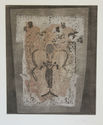
19th, 20th & 21st Century Fine Prints
707-546-7352 · fax 707-546-7924 · web: www.annexgalleries.com · email: artannex@aol.com
Wilfried Satty Biography
Wilfried Satty
German - American
1939–1982
Biography
Wilfried (Wilfred) Podriech, known as Sätty was born in Bremen, Germany, on April 12, 1939. As a child he played in the surreal world of the ruins of the city, which was heavily bombed during World War II. After three years of apprenticeship in mechanical engineering, he worked in Brasilia, moving to San Francisco, California in 1961.
In San Francisco he lived in North Beach, and associated with artists and bohemians of the Beat Generation. In 1966, inspired by the openness and creativity of San Francisco’s emergent Hippie and psychedelic culture, he began making pictorial collages. Some of these were sold as poster size prints, which were then very popular. He intended his art to engage the imagination and counteract the pernicious stimulus-response programming of media advertising.
Renting a studio at 2141/43 Powell Street in San Francisco he created “The North Beach U-Boat”, what the late SF Chronicle art critic Thomas Albright described as:
"a surreal environment that resembled a cross between Mrs. Havisham's parlor in Great Expectations and something out of Luna Park. Using detritus he had found in trash bins of the more affluent Satty covered the dirt floor with oriental carpets, the walls with fur and mirrors, and created a " warren of variously weird compartments like the different rooms in Hesse's Magic Theater." It was said to have "as many levels and ladders, as a Hopi Indian pueblo." Baby dolls, alchemy books, a human skull, a large incense burner were all part of the decor.
Sätty created many colorful artworks and lithographic prints, and hundreds of black and white collages. During the 1970s many were used as illustrations in both the counter culture and establishment periodicals. He produced two collage books, The Cosmic Bicycle and Time Zone, a pictorial allegory. He created illustrations for the comprehensive treatise, The Annotated Dracula and for The Illustrated Edgar Allen Poe, a book of stories he selected.
During the late 1970s until his death in 1982, he produced numerous collages inspired by events in San Francisco’s often dramatic, unruly history, from the Gold Rush to the 1890s. Many of these occasionally bizarre images have recently been published in Visions of Frisco, by Regent Press, Berkeley.
In a review of Sätty’s art, S.F. Chronicle art critic Thomas Albright stated, “His work evidenced his Germanic roots with a somber, dreamlike realm of utopian, surrealist fantasy spiced by disarming accents of the bizarre and grotesque.”
Satty's art has been exhibited in many galleries and museums, including the San Francisco Museum of Modern Art; the Museum of Modern Art, New York; the Boston Museum of Fine Arts; the National Museum of Art, Belgrade; and the National Museum, Warsaw.
Satty died in San Francisco on January 31, 1982 after a fall from one of the ladders in his studio.
Walter Medeiros, The Archive of Counter Culture Art and other sources.

